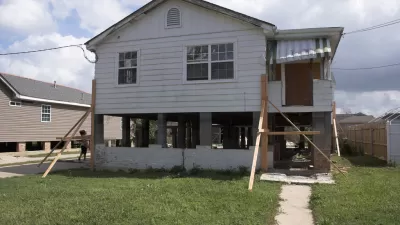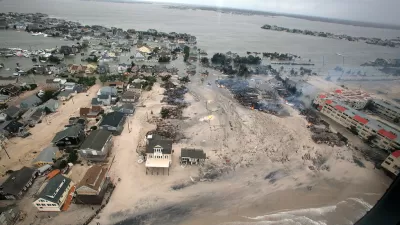In the wake of Superstorm Sandy, a new task force convened by New York's Mayor Michael R. Bloomberg and City Council speaker Christine C. Quinn will look into potential changes to the city's building code, with recommendations due next summer.
The Building Resiliency Task Force, to be chaired by Russell Unger, executive director of the Urban Green Council, is being charged with taking "an in-depth look at how to prepare city buildings for future storms and infrastructure failures." As Unger told reporter Mireya Navarro, "the new group would need to address both direct impacts from the storm, like structure collapse and flooding, and secondary ones, like power losses from utility failures."
"Some of the potential measures [to be considered] are relatively simple, like keeping sandbags handy and installing floodgates at building entrances. Others are more complicated, like relocating critical equipment like boilers above ground level or encasing them in watertight enclosures and rebuilding houses on concrete piles."
"What does not seem to be getting consideration, at least for now, is banning development altogether in the city’s flood zones, humble or affluent," says Navarro.
“'This is not a viable policy option in New York City, and to be honest, nor is it in any other major coastal city I’ve been working,' said Jeroen Aerts, a water risk expert from the Free University in Amsterdam who has been hired by the mayor’s office to assess flood protections. 'The stakes of developers and general economic activities in the waterfront are too high.'”
FULL STORY: After Storm, Dry Floors Prove Value of Exceeding City Code

Manufactured Crisis: Losing the Nation’s Largest Source of Unsubsidized Affordable Housing
Manufactured housing communities have long been an affordable housing option for millions of people living in the U.S., but that affordability is disappearing rapidly. How did we get here?

Americans May Be Stuck — But Why?
Americans are moving a lot less than they once did, and that is a problem. While Yoni Applebaum, in his highly-publicized article Stuck, gets the reasons badly wrong, it's still important to ask: why are we moving so much less than before?

Using Old Oil and Gas Wells for Green Energy Storage
Penn State researchers have found that repurposing abandoned oil and gas wells for geothermal-assisted compressed-air energy storage can boost efficiency, reduce environmental risks, and support clean energy and job transitions.

Updating LA’s Tree Rules Could Bring More Shade to Underserved Neighborhoods
A new USC study finds that relaxing Los Angeles’ outdated tree planting guidelines could significantly expand urban tree canopy and reduce shade disparities in lower-income neighborhoods, though infrastructure investments are also needed.

California's Canal Solar Projects Aim to Conserve Resources and Expand Clean Energy
California’s Project Nexus has begun generating electricity from solar panels installed over irrigation canals, with researchers and state agencies exploring statewide expansion to conserve water and boost clean energy production.

HHS Staff Cuts Gut Energy Assistance Program
The full staff of a federal program that distributes heating and cooling assistance for low-income families was laid off, jeopardizing the program’s operations.
Urban Design for Planners 1: Software Tools
This six-course series explores essential urban design concepts using open source software and equips planners with the tools they need to participate fully in the urban design process.
Planning for Universal Design
Learn the tools for implementing Universal Design in planning regulations.
Heyer Gruel & Associates PA
City of Moreno Valley
Institute for Housing and Urban Development Studies (IHS)
City of Grandview
Harvard GSD Executive Education
Salt Lake City
NYU Wagner Graduate School of Public Service
City of Cambridge, Maryland




























